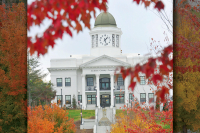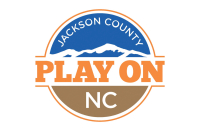Huge success for Canton Labor Day fest

The longest running Labor Day festival in the South is meant to commemorate the contributions of the organized labor movement in the Unites States; appropriately, the Town of Canton’s popular weekend event wasn’t just spent guzzling sweet tea, pounding barbecue and listening to bluegrass.
It was spent building something.
“It was a big success,” said Canton Town Manager Seth Hendler-Voss. “It’s just an estimate, but it’s based on about five to six square feet per person. We think about 5,500 came on Monday, 3,500 on Sunday, and we’re guessing about 5,000 for the parade. So somewhere around 14,000.”
But bringing 14,000 people out to an event in a town of less than 5,000 residents isn’t the only way Canton officials will measure that success.
“We measure it based on the amount of town subsidy,” Hendler-Voss said. “The board set a subsidy maximum for us of $10,000 and looking at preliminary numbers right now, it looks like we’ll be at or under that subsidy.”
Most revenue from the festival comes from sponsors; in the event that revenue does not meet expenditures, the town would step in to ensure the event doesn’t end up in the red.
Related Items
“By that measure, the festival was a success and we hope to get to the point where we’re self-sustaining and there is no town subsidy,” he said.
Of note, Hendler-Voss said the Papertown Kids Village, which featured six inflatable attractions, a free face painter and a balloon artist — brought in about $7,000. Admission was $10 for the entire day.
Although a children’s play area may seem somewhat trivial in the grand scheme of a large outdoor summer holiday festival, it represents an important — and in this case, fruitful — way to monetize a free event that doesn’t sell alcohol, which is often a major revenue source for such fetes.
Hendler-Voss said he’d like to see the festival eventually become self-sustaining.
“Of course, to be able to do that, we need more revenue,” he said. “Primarily through sponsorships and other sources.”
Indeed, in the months leading up to the festival, some members of the public appeared before the town board to bemoan the fact that the estimated 14,000 attendees — some from as far away as Germany — could theoretically visit Canton without leaving so much as a nickel behind.
Financials aside, Canton of late has been fighting to position itself as a sensible option to overpriced, overcrowded Asheville despite having the highest property taxes in Haywood County.
Over the past few months, Canton successfully wooed Western Carolina Freightliner from Asheville to a long-vacant parcel near Interstate 40, announced the addition of a craft brewery, and embarked on a much-needed streetscaping project designed to beautify historic downtown and appeal not only to long-time residents, but also outsiders.
A recent study issued by the Haywood County Affordable Housing Task Force opined that the key to population growth in the county over the next 30 years is in-migration — not natural increase — making the festival an important way for the town to raise awareness of its existence among people who don’t seem to realize that there are actually towns in North Carolina west of Asheville.
To that end, Hendler-Voss cited the diversity of the crowd attending the festival.
“It was probably the most diverse crowd of visitors Canton has ever experienced,” he said.
Canton Mayor Mike Ray agreed.
“Labor Day was a great Labor Day,” he said. “We had a lot of great entertainment, a very unique mixture, a very good mixture of people from different areas.”
That mixture came largely as the result of headliners Yonder Mountain String Band, known for their dedicated and freewheeling crowd; YMSB contrasted somewhat with Nash-pop sensation Joe Lasher Jr., and more traditional acts like Haywood County’s critically acclaimed Balsam Range.
Hendler-Voss cited a Facebook post as evidence thereof.
“Someone said, ‘You know what, all the hippies are welcome to come out for Yonder Mountain String Band, but this redneck’s gonna stay home and I’ll be out there for Balsam Range.’ So my reply was that everyone’s welcome — we’re bridging cultures here. I mean, he was joking, but it is true. Who ever thought that the little town of Canton, which is very monochromatic, would host such a diverse collection of people?”
He went on to say that he hoped visitors would walk away with the impression of Canton as a town that knows how to throw a quality event, values cultural diversity and celebrates a rich heritage, but also competes for growth and relevance in a region where Asheville and the Great Smoky Mountains National Park easily overshadow the small, proud, mountain mill town.
Next year’s festival — the town’s 111th annual — will give Canton yet another opportunity to market itself to the outside world; however, this year’s event set a high bar to top, as it marked a significant departure from the smaller, less extravagant festivals of years past.
As to whether it’ll continue in its expanded fashion, Mayor Ray deferred to the people of Canton.
“That’s for the community to decide,” Ray said. “Our residents — we’re doing this for those people, not necessarily for ourselves.”
Regardless, Hendler-Voss’ said he was proud of the event.
“We need to build on this year’s success so we can essentially galvanize the impression that people on the outside have of Canton and solidify our standing as a first-choice event for Labor Day weekend,” he said. “But we also have to be careful to continue to strike that balance of showcasing our history and our heritage while also embracing the new music and the changing demographics. I’d like to expand the diversity. We made great strides this year. We had more diversity this year culturally — ethnic and racial diversity — than probably ever before, and we need to grow on that, because that’s the trend of our region.”
Thus it seems that in the Town of Canton, the Labor Day festival’s success isn’t really based on how much money it raised or how many people it drew, but rather on what residents and visitors built, together.
“If we’re making paper yesterday,” Hendler-Voss said, “we’re building bridges today.”









